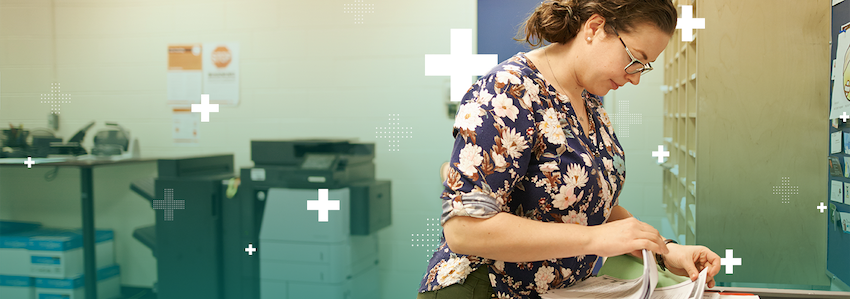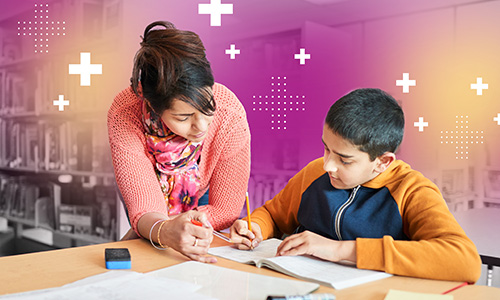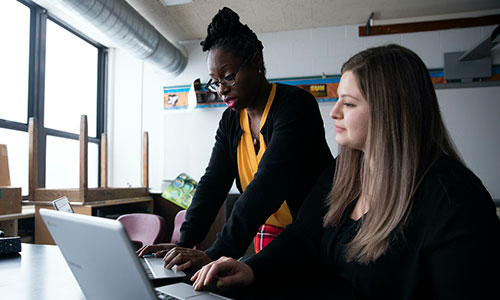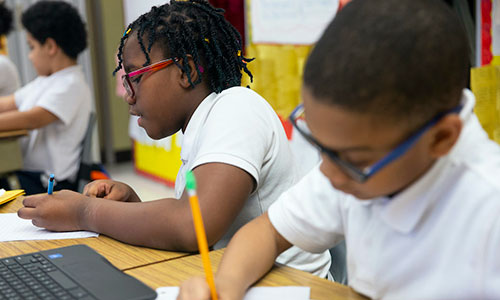
Back in May, the Continuing Educator podcast wrapped up its season with a special episode highlighting success stories, novel teaching ideas, and fun memories shared by podcast listeners. In “Voicemails from our listeners,” co-hosts Jacob Bruno, executive vice president of Learning & Improvement Services at NWEA, and middle school math teacher Kailey Rhodes heard from teachers about some of their best classroom experiences and favorite classroom tools, including Mr. Potato Head.
In this post, we’ll learn about some of the classroom tools these teachers are using every day to improve instruction and build a stronger classroom culture—and we’ll get Jacob and Kailey’s in-the-moment reactions to these words of wisdom.
Best extrinsic motivators?
Calling in from Allen, Texas, Tanji shares her favorite extrinsic motivator: none other than Mr. Potato Head. “My students have always loved having him in our classroom,” she says. “And as they make good choices, show good behaviors, and kindness toward one another, we add body parts to Mr. Potato Head. And once we have him whole, they win some type of whole-class reward.”
Kailey: “That is the cutest thing I’ve ever heard in my life.”
Jacob: “All ages can come together for a common end. And if that is to make a potato man whole, all the better. I love it.”
For listener Sarah, hailing from Jefferson County, Kentucky, one of the best extrinsic motivators involves picking up the phone. Together as a class, she and her students nominate a student who did something special on a given day, and she calls their parents or guardians to share the class’s praise. Not only do her students enjoy nominating each other for a positive phone call, but sometimes this gesture of kindness comes right back to Sarah.
“I had a student who started asking, on days when she really liked a lesson, if she could call my mom,” says Sarah. “And so I had a student who would call my mom at the end of the day and tell her if I had a really good lesson or if I did something that she really liked. And it was such a cool experience because my student wanted me to have the same reward and feeling that she experienced.”
Jacob: “My friend and colleague here, Kailey, is tearing up. What a touching share.”
Kailey: “Oh my god, that is the sweetest thing. […] I think these kids are going to heal us, y’all.”
What’s in your teaching cabinet?
For Shelby, a high school English teacher in Decatur, Georgia, playing dress-up can actually be a powerful learning activity. That’s why she keeps several large Tupperware containers in her classroom fully stocked with costumes.
“No matter what the age, my students constantly ask for me to pull [the costumes] out,” she says. “We play all kinds of games with them. Even in my international baccalaureate classes, we do various charade games. […] We might do skits, and the seniors might be studying different rhetorical devices.”
Kailey: “You’re a legend! […] Costumes are truly a liberating device.”
Jacob: “This is student engagement personified.”
Over in Jefferson County, Kentucky, Sarah keeps morning choice boxes in her cabinet, which allow her students to start their school day by essentially choosing their own adventure, whether it’s coloring, working with Legos, or playing math games.
“They got to make that choice first thing in the morning about what they were going to do,” Sarah explains. “And it really helped with self-monitoring in my class. […] Some of the best learning came from those experiences because getting to see my kids come in and say, ‘You know what? I had a really hard morning. I need to take some time by myself, or I learned a new game, or that friend has Uno and I want to play with them.’ It really helped our environment.”
Kailey reacts: “That is huge. […] Kids are relaxed when they know they get to make a choice.”
Jacob reacts: “I think this is a really novel and ingenious way to keep kids engaged and start their day off right.”
Favorite use for Post-it notes?
Back to Shelby in Decatur: “My favorite use for Post-it notes goes back to my very first year of teaching. […] Whenever we have our parent open house night, I like to put Post-it notes and markers all around the room and I ask parents to leave a note for their student. […] When the students come back to my classroom the next day, they’re always just so touched by their notes. […] I think it’s a way for students to feel like their parent is in the room and a part of their experience in the classroom.
Jacob: “Shelby, that’s just beautiful. […] It’s about being cared for. It’s about being seen.”
Kailey: “And realizing that school is not a pause on your life; school is part of your life.”
For Sarah in Kentucky, Post-its are her go-to tool for an activity she calls the “30-second speech.” She explains: “You can give kiddos a Post-it upside down and when they flip it over, they reveal a word and they have to instantly give a 30-second speech about it. And this could be something really funny and silly. They have to become the expert. So, let’s say maybe they flip over the Post-it and they have the word ‘alligator’ and they have to come up with a 30-second speech on the spot [explaining] why an alligator is the worst pet or why alligators are the best animal.”
Kailey: “You’re a freaking genius. I don’t even know what to say.”
Jacob: “The thing that I love about this is—what a disarming way to help deal with one of humanity’s biggest nervous things: public speaking.”
(For more great Post-it ideas, check out this episode of The Continuing Educator: “Fuzzy feelings and wardrobe malfunctions.”)
Best compliment?
The podcast audience also had plenty to say about the best compliments they’ve received at school, whether from adults or from students. Tanji kicked off this part of the show by recalling the time a parent told her that their child’s reading growth had really taken off under her instruction.
“To know that I’ve been part of bringing the love, the joy, and the ability to read to a student… That’s always going to be one of the biggest compliments I can ever get from a parent about their student,” she says.
Jacob: “Tanji, I just have to applaud you. […] I think a lot of times teaching can seem like rowing a small boat across the ocean for a long time. You lose perspective. […] But you’re really getting somewhere.”
Kailey: “Teaching, I often say, is the highest highs and the absolute lowest lows. That moment of being told that you have impacted a child’s ability to read [is] huge. Like, that’s enormous.”
Want to hear more?
If you’ve enjoyed hearing these reflections from listeners of the Continuing Educator podcast, there’s more to discover. Listen to the podcast episode for more useful tips, meaningful stories, and interesting ideas for new classroom tools.







